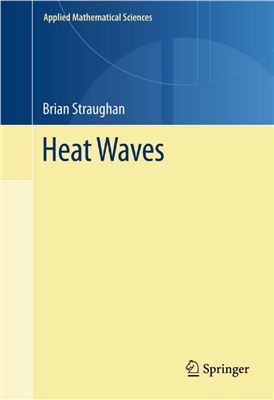Springer Science+Business Media, 2011, 318 pages
This book surveys significant mode contributions to the mathematical theories of generalized heat wave equations. The first three chapters form a comprehensive survey of most mode contributions also describing in detail the mathematical properties of each model. Acceleration waves and shock waves are the focus in the next two chapters. Numerical techniques, continuous data dependence, and spatial stability of the solution in a cylinder, feature prominently among other topics treated in the following two chapters. The final two chapters are devoted to a description of selected applications and the corresponding formation of mathematical models. Illustrations are taken from a broad range that includes nanofluids, porous media, thin films, nuclear reactors, traffic flow, biology, and medicine, all of contemporary active technological importance and interest.
This book is devoted to an account of theories of heat conduction where the temperature may travel as a wave with a finite speed. This area of nonclassical diffusion is very topical in the research literature. With the advent of micro-scale technology there is increasing evidence that thermal motion is via a wave mechanism as opposed to by diffusion. We survey many of the theories which have been proposed as candidates to describe thermal motion as a wave. These theories are linked to solid mechanics (elasticity) and also to fluid mechanics. Wave motion in the form of acceleration waves and of shock waves is discussed. An exposition of numerical work in the area of thermal waves is also included. Analytical methods for establishing uniqueness, continuous dependence, growth, spatial decay and other results are described.
This book will be of value to applied mathematicians, theoretical engineers and other practitioners who wish to know both the theory and its relevance to diverse applications.
This book surveys significant mode contributions to the mathematical theories of generalized heat wave equations. The first three chapters form a comprehensive survey of most mode contributions also describing in detail the mathematical properties of each model. Acceleration waves and shock waves are the focus in the next two chapters. Numerical techniques, continuous data dependence, and spatial stability of the solution in a cylinder, feature prominently among other topics treated in the following two chapters. The final two chapters are devoted to a description of selected applications and the corresponding formation of mathematical models. Illustrations are taken from a broad range that includes nanofluids, porous media, thin films, nuclear reactors, traffic flow, biology, and medicine, all of contemporary active technological importance and interest.
This book is devoted to an account of theories of heat conduction where the temperature may travel as a wave with a finite speed. This area of nonclassical diffusion is very topical in the research literature. With the advent of micro-scale technology there is increasing evidence that thermal motion is via a wave mechanism as opposed to by diffusion. We survey many of the theories which have been proposed as candidates to describe thermal motion as a wave. These theories are linked to solid mechanics (elasticity) and also to fluid mechanics. Wave motion in the form of acceleration waves and of shock waves is discussed. An exposition of numerical work in the area of thermal waves is also included. Analytical methods for establishing uniqueness, continuous dependence, growth, spatial decay and other results are described.
This book will be of value to applied mathematicians, theoretical engineers and other practitioners who wish to know both the theory and its relevance to diverse applications.

